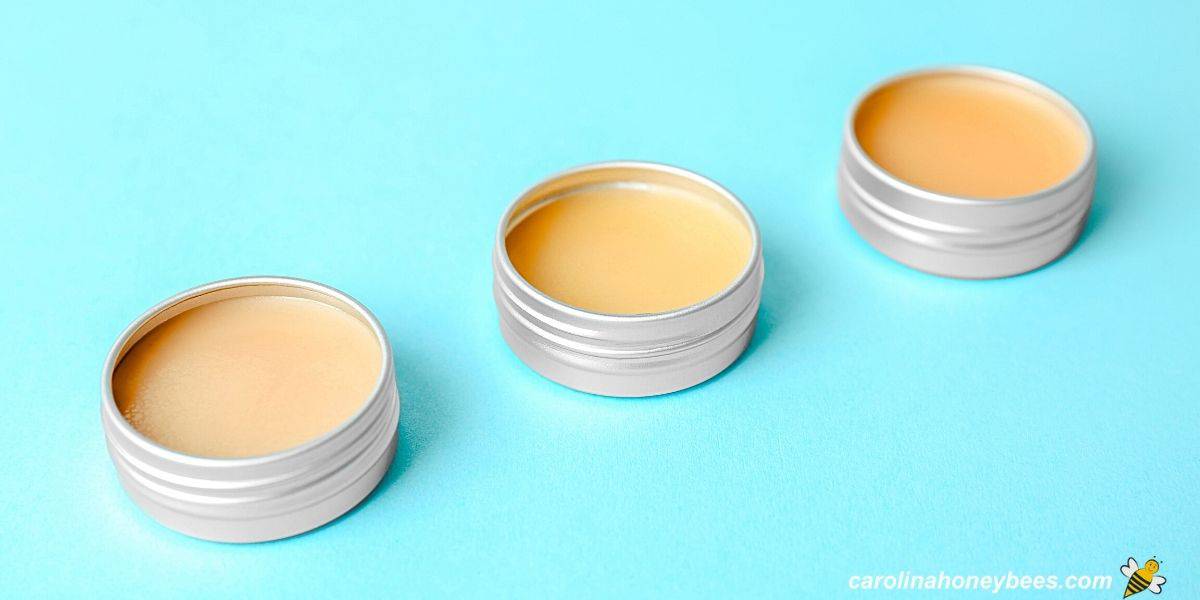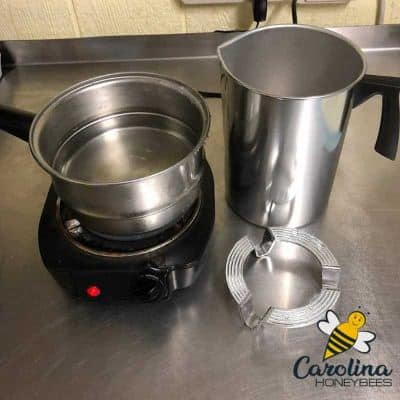Beeswax Balm for Your Feet
Making a homemade beeswax balm is a great way to show our feet some love. This isn’t just any foot balm; it’s a potion crafted with the wisdom of busy bees and the satisfaction of a DIY touch. Loved by many, this recipe for beeswax foot balm is a favorite for dry, cracked heels.

A natural wax made by honey bees, beeswax is no stranger to the health and beauty industry. Using beeswax for skin care is nothing new and has been practiced for years.
Why Make Beeswax Balm for Your Feet
Cracked heels is a common problem for many of us during the harsh cold season of the year. The problem can become very troublesome and require extra care – beyond daily lotions.
This is where the remarkable properties of beeswax come into play. It acts as a natural emollient and seals in existing moisture. Beeswax also forms a light protective barrier to reduce drying of the skin.
Why Beeswax is Really Good for Cracked Heels
If you suffer from rough, cracked heels ( I do – especially in Winter), you probably already know that lotion doesn’t seem to help very much. It doesn’t seem to last long and I forget to apply it every day.
But, this recipe for homemade beeswax balm works so well because it is heavier and thicker. You are able to rubs the balm down into the cracks of the heel and it stays put. It doesn’t rub off as easily as a thinner product.
This post may contain affiliate links. As an Amazon Associate, I earn from qualifying purchases. Please read my disclosure.
Materials
In order to create your foot care masterpiece, you just need to combine just a few ingredients and supplies.
- Beeswax
- Shea Butter
- Coconut Oil
- Vitamin E Oil (optional)
- Lavender Essential Oil (optional)
- Tea Tree Essential Oil (optional)
Beeswax
You can purchase beeswax in a variety of forms: bars, chunks, pellets, etc. All work well and it really does not matter which color of beeswax you use – light shades are usually best.
Perhaps you are a beekeeper with some extra beeswax on hand. If so, you only need to clean your beeswax before beginning your recipe.
Butters & Oils
If you have ever held a bar of fresh beeswax, you will know that it is a solid that can not be rubbed into your skin. This wax needs some help from other ingredients to become useful for skin care.
Soft butters and oils combined with beeswax create a luxurious, moisturizing product with a semi-solid consistency.
Essential Oils
Any skin safe essential oils can be added to your DIY beeswax balm. They have some soothing properties and offer an aromatherapy benefit.

Tools Needed
Very little equipment is needed for this recipe. It is best to used a double boiler (stove top) or glass container (microwave safe) for melting the ingredients.
I prefer to not use the microwave so my instructions will involve melting ingredients on the stove top. If you want to use a microwave, that is okay. Go slow, using very short times to safely melt your ingredients – and constant supervision.
I use a pot, a simple double boiler insert and a wax pouring pot. Some craft sticks of wood are useful to mix our ingredients. And, don’t forget you need container to pour the finished foot balm recipe into.
**This information is shared as one way to use beeswax for natural products. Use all safety precautions to avoid burns or other possible effects of using the product. I am not a doctor – use this product at your own risk. **
The Process – Making It

1. Using a double boiler or similar setup, melt the beeswax, shea butter and coconut oil. Watch it closely, do not over heat. This should be a slow and gentle process.
Another option is to purchase one of these little double boiler inserts and use it as the top pot – placed in a pot with water. I love them and have several.
2. Prepare a pouring work surface-protect your table with a layer of foil, wax paper or similar. If you want to use essential oils- have them ready.
3. When all ingredients are melted and combined, remove from heat – add essential oils and vitamin E oil if desired. Then, pour into smaller containers.
If you are using glass, pre-warm them with hot water and dry – before pouring hot wax into them. Metal tins and plastic cups are other good choices for containers.
4. Once the beeswax balm is cool and set. Add a lid to each container and a label.
Expert Tips
This recipe is a general formula. It is very forgiving, you can remelt and tweak the ingredients a bit. If you want a less solid product – remelt and add a bit more coconut oil.
If you find it to be too liquid in warm weather, adding a bit more beeswax should help. That is one of the wonderful properties of working with beeswax.Our goal is to mix solid ingredients with softer oils such as coconut oil, shea butter etc. The resulting combination is a product that is harder than lotion – yet pliable enough to spread.
Using Beeswax Balm
Apply your beeswax balm to dry heels before bed. Do a thorough job and really rub it into the cracks around the heel.
Cover with socks to prevent stains on clothing or falls – it will feel slick-don’t walk without socks. By the next morning most of the balm should be absorbed into your skin. Repeat as needed and you should see a big difference.
Using homemade recipes to making your own products is a good way to know exactly what you are putting on your body. You do not have to worry about possibly dangerous chemicals being in your balms.
Educate others on the contributions of honey bees and the many ways to use beeswax and other hive products.
More Ideas
If you enjoyed making this project, it’s time to consider pampering your lips now. You can make beeswax lip balm with a minimum of fuss. Or, perhaps you might prefer hard beeswax lotion bars with essential oils.
Healing salves can be made with beeswax and plant materials: dandelion salve, calendula salve and even herbal plantain salve to name a few.
Planning to spend some time outside? Try this DIY bug bite relief stick that uses beeswax and essential oils to soothe irritated skin. And if Rover is experiencing some paw dryness – you can make your own dog paw balm too!
Final Thoughts
After the honey harvest, beekeepers have some wax left over. The wax is quite valuable and actually sells for more per pound than honey. In addition to making beeswax candles, you can find guides to make many ointments, beeswax lotions and others items. Don’t let this guide for beeswax foot balm be your last experience with this wonderful product.

Beeswax Balm for Feet Recipe
This post may contain affiliate links. As an Amazon Associate, I earn from qualifying purchases.
Read my Disclosure.Tools
- 1 double boiler (pot to melt wax) (or similar)
Supplies
- 4 oz beeswax
- 4 oz shea butter
- 5 oz coconut oil
- 3 drops vitamin E oil (optional)
- 10 drops Essential Oil (I used Lavender) (optional)
- 10 drops tea tree essential oil (optional)
Instructions
- Melt the beeswax and other Ingredients. For a standard double boiler (dedicated to wax crafting) put water in the bottom half and your ingredients in the top pot.Or you can improvise one using little double boiler inserts and stacking pots. Place the beeswax and shea butter in the top melting container. Once the wax and shea butter are half melted, you can add the coconut oil.Coconut oil melts very quickly. Beeswax takes longer to melt. Cutting it into smaller chunks will speed melting.

- While the wax is melting -prepare working surface and containers. Working with hot beeswax can be messy. Cover your work surface with a large piece of aluminum foil, wax paper or parchment. This makes clean up a breeze. You also need some type of containers to hold your finished product. If you are making this recipe for yourself, a wide-mouth pint jar is fine. Smaller containers are good for gift-giving. If you are using glass, pre-warm them with hot water and dry – before pouring hot wax into them. Metal tins and plastic cups are other good choices for containers.

- Add Vitamin E and essential oils then pour up. When all the ingredients have completely melted, remove from the heat source. It is a good idea to avoid over-heating your ingredients. This can harm some of their beneficial properties.Add Vitamin E and essential oils – if desired. Neither is necessary. However, the vitamin e helps your beeswax balm last longer. The essential oils offer a pleasing fragrance and has some soothing qualities too.Carefully, pour your ingredients into their final containers. While the pouring pot is hot, a quick wipe with a paper towel to remove any residue left inside.

- Allow Beeswax Balm to cool and seal. Leave the lids off until the beeswax foot balm has cooled. It should become semi-solid in an hour or so.Then, put lids on your jars (or other containers) and your product is ready to use. Be sure to add a label so you will remember what it is for.

Notes
- always take care when melting wax to avoid fire or burns





